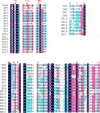Identification and Predictions Regarding the Biosynthesis Pathway of Polyene Macrolides Produced by Streptomyces roseoflavus Men-myco-93-63
- PMID: 33637575
- PMCID: PMC8117769
- DOI: 10.1128/AEM.03157-20
Identification and Predictions Regarding the Biosynthesis Pathway of Polyene Macrolides Produced by Streptomyces roseoflavus Men-myco-93-63
Erratum in
-
Correction for Han et al., "Identification and Predictions Regarding the Biosynthesis Pathway of Polyene Macrolides Produced by Streptomyces roseoflavus Men-myco-93-63".Appl Environ Microbiol. 2021 Jun 11;87(13):e0080221. doi: 10.1128/AEM.00802-21. Epub 2021 Jun 11. Appl Environ Microbiol. 2021. PMID: 34114900 Free PMC article. No abstract available.
Abstract
A group of polyene macrolides mainly composed of two constituents was isolated from the fermentation broth of Streptomyces roseoflavus Men-myco-93-63, which was isolated from soil where potato scabs were repressed naturally. One of these macrolides was roflamycoin, which was first reported in 1968, and the other was a novel compound named Men-myco-A, which had one methylene unit more than roflamycoin. Together, they were designated RM. This group of antibiotics exhibited broad-spectrum antifungal activities in vitro against 17 plant-pathogenic fungi, with 50% effective concentrations (EC50) of 2.05 to 7.09 μg/ml and 90% effective concentrations (EC90) of 4.32 to 54.45 μg/ml, which indicates their potential use in plant disease control. Furthermore, their biosynthetic gene cluster was identified, and the associated biosynthetic assembly line was proposed based on a module and domain analysis of polyketide synthases (PKSs), supported by findings from gene inactivation experiments.IMPORTANCEStreptomyces roseoflavus Men-myco-93-63 is a biocontrol strain that has been studied in our laboratory for many years and exhibits a good inhibitory effect in many crop diseases. Therefore, the identification of antimicrobial metabolites is necessary and our main objective. In this work, chemical, bioinformatic, and molecular biological methods were combined to identify the structures and biosynthesis of the active metabolites. This work provides a new alternative agent for the biological control of plant diseases and is helpful for improving both the properties and yield of the antibiotics via genetic engineering.
Keywords: Streptomyces roseoflavus Men-myco-93-63; antibiotic; antifungal activity; biosynthetic gene cluster; polyene macrolide.
Copyright © 2021 American Society for Microbiology.
Figures







Similar articles
-
Characterization of the biosynthetic gene cluster of the polyene macrolide antibiotic reedsmycins from a marine-derived Streptomyces strain.Microb Cell Fact. 2018 Jun 19;17(1):98. doi: 10.1186/s12934-018-0943-6. Microb Cell Fact. 2018. PMID: 29914489 Free PMC article.
-
New nystatin-related antifungal polyene macrolides with altered polyol region generated via biosynthetic engineering of Streptomyces noursei.Appl Environ Microbiol. 2011 Sep;77(18):6636-43. doi: 10.1128/AEM.05780-11. Epub 2011 Jul 15. Appl Environ Microbiol. 2011. PMID: 21764946 Free PMC article.
-
Identification of a critical gene involved in the biosynthesis of the polyene macrolide lavencidin in Streptomyces lavendulae FRI-5 using the Target-AID (activation-induced cytidine deaminase) base editing technology.Appl Environ Microbiol. 2025 May 21;91(5):e0097524. doi: 10.1128/aem.00975-24. Epub 2025 Apr 22. Appl Environ Microbiol. 2025. PMID: 40261024 Free PMC article.
-
Biosynthesis and pathway engineering of antifungal polyene macrolides in actinomycetes.J Ind Microbiol Biotechnol. 2013 Jun;40(6):529-43. doi: 10.1007/s10295-013-1258-6. Epub 2013 Mar 21. J Ind Microbiol Biotechnol. 2013. PMID: 23515854 Review.
-
Polyene macrolide biosynthesis in streptomycetes and related bacteria: recent advances from genome sequencing and experimental studies.Appl Microbiol Biotechnol. 2016 May;100(9):3893-908. doi: 10.1007/s00253-016-7474-z. Epub 2016 Mar 29. Appl Microbiol Biotechnol. 2016. PMID: 27023916 Review.
Cited by
-
Untargeted Metabolomics Sheds Light on the Secondary Metabolism of Fungi Triggered by Choline-Based Ionic Liquids.Front Microbiol. 2022 Jul 25;13:946286. doi: 10.3389/fmicb.2022.946286. eCollection 2022. Front Microbiol. 2022. PMID: 35958129 Free PMC article.
-
Effects of Chemical and Biological Fungicide Applications on Sexual Sporulation of Rhizoctonia solani AG-3 TB on Tobacco.Life (Basel). 2024 Mar 18;14(3):404. doi: 10.3390/life14030404. Life (Basel). 2024. PMID: 38541728 Free PMC article.
-
Streptomyces can be an excellent plant growth manager.World J Microbiol Biotechnol. 2022 Aug 18;38(11):193. doi: 10.1007/s11274-022-03380-8. World J Microbiol Biotechnol. 2022. PMID: 35980475 Review.
-
Identification of RimR2 as a positive pathway-specific regulator of rimocidin biosynthesis in Streptomyces rimosus M527.Microb Cell Fact. 2023 Feb 21;22(1):32. doi: 10.1186/s12934-023-02039-9. Microb Cell Fact. 2023. PMID: 36810073 Free PMC article.
-
The Discovery of Actinospene, a New Polyene Macrolide with Broad Activity against Plant Fungal Pathogens and Pathogenic Yeasts.Molecules. 2021 Nov 20;26(22):7020. doi: 10.3390/molecules26227020. Molecules. 2021. PMID: 34834113 Free PMC article.
References
-
- Bentley SD, Chater KF, Cerdeno-Tarraga AM, Challis GL, Thomson NR, James KD, Harris DE, Quail MA, Kieser H, Harper D, Bateman A, Brown S, Chandra G, Chen CW, Collins M, Cronin A, Fraser A, Goble A, Hidalgo J, Hornsby T, Howarth S, Huang CH, Kieser T, Larke L, Murphy L, Oliver K, O'Neil S, Rabbinowitsch E, Rajandream MA, Rutherford K, Rutter S, Seeger K, Saunders D, Sharp S, Squares R, Squares S, Taylor K, Warren T, Wietzorrek A, Woodward J, Barrell BG, Parkhill J, Hopwood DA. 2002. Complete genome sequence of the model actinomycete Streptomyces coelicolor A3(2). Nature 417:141–147. 10.1038/417141a. - DOI - PubMed
-
- Letek M, Mateos LM, Gil JA. 2014. Genetic analysis and manipulation of polyene antibiotic gene clusters as a way to produce more effective antifungal compounds, p 177–214. In Antimicrobial compounds. Springer, New York, NY.
-
- Brautaset T, Sekurova ON, Sletta H, Ellingsen TE, StrŁm AR, Valla S, Zotchev SB. 2000. Biosynthesis of the polyene antifungal antibiotic nystatin in Streptomyces noursei ATCC 11455: analysis of the gene cluster and deduction of the biosynthetic pathway. Chem Biol 7:395–403. 10.1016/S1074-5521(00)00120-4. - DOI - PubMed
Publication types
MeSH terms
Substances
Supplementary concepts
LinkOut - more resources
Full Text Sources
Other Literature Sources

